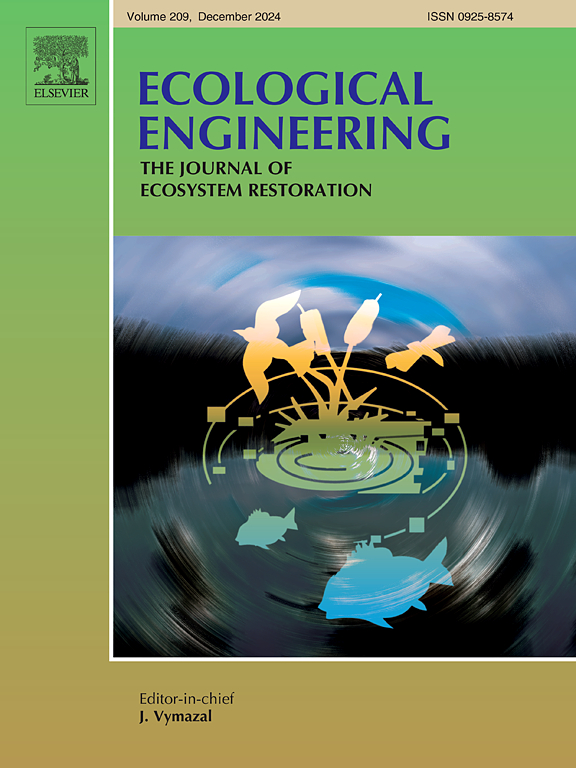Influences of mangrove species on the carbon release of the decomposed leaf litter in the restored mangrove forests with different site elevations
IF 3.9
2区 环境科学与生态学
Q1 ECOLOGY
引用次数: 0
Abstract
Leaf litter decomposition is one of the main carbon release pathways in mangrove forests. Mangrove species and site elevation are important factors for successful restoration of mangrove forests. Carbon sequestration capacity is an important parameter for functional restoration of mangrove ecosystems. The combined influences of mangrove species (Kandelia obovata vs Avicennia marina) and site elevation (low site elevation vs high site elevation) on the carbon release of decomposed leaf litter were seasonally quantified through litterbag method from April 2018 to February 2019. At high elevation site (higher than local mean elevation, 375 cm vs 365 cm), the annual average carbon release of decomposed leaf litter in the A. marina forest (37.04 ± 9.78 g C m−2, 57.3 %) was significantly higher than that in the K. obovata forest (36.14 ± 8.85 g C m−2, 52.9 %), because of faster decomposition rate of leaf litter in the A. marina forest. For low elevation site (lower than local mean elevation, 335 cm vs 365 cm), the annual average carbon release of leaf litter in the A. marina forest (33.56 ± 11.33 g C m−2, 53.2 %) was similar to that in the K. obovata forest (35.65 ± 7.35 g C m−2, 52.5 %). These results suggested that K. obovata should be selected at high elevation site for mangrove restoration to minimize carbon release in view of carbon release of decomposed leaf litter.
不同立地海拔红树林树种对恢复红树林凋落叶碳释放的影响
凋落叶分解是红树林碳释放的主要途径之一。红树林的种类和立地海拔是红树林恢复成功的重要因素。固碳能力是红树林生态系统功能恢复的重要参数。2018年4月至2019年2月,采用凋落物袋法定量分析了红树树种(红树与黄树)和立地海拔(低立地海拔与高立地海拔)对凋落叶碳释放的联合影响。在高海拔立地(高于当地平均海拔,375 cm vs 365 cm),林分凋落叶的年平均碳释放量(37.04±9.78 g C m−2,57.3%)显著高于倒叶猴林分凋落叶的年平均碳释放量(36.14±8.85 g C m−2,52.9%),这是因为林分凋落叶分解速度更快。在低海拔地区(低于当地平均海拔335 cm vs 365 cm),林分凋落叶的年平均碳释放量(33.56±11.33 g C m−2,53.2%)与林分凋落叶的年平均碳释放量(35.65±7.35 g C m−2,52.5%)相似。综上所示,考虑到腐叶凋落物的碳释放,应在高海拔红树林恢复地选择倒卵黄,以减少碳释放。
本文章由计算机程序翻译,如有差异,请以英文原文为准。
求助全文
约1分钟内获得全文
求助全文
来源期刊

Ecological Engineering
环境科学-工程:环境
CiteScore
8.00
自引率
5.30%
发文量
293
审稿时长
57 days
期刊介绍:
Ecological engineering has been defined as the design of ecosystems for the mutual benefit of humans and nature. The journal is meant for ecologists who, because of their research interests or occupation, are involved in designing, monitoring, or restoring ecosystems, and can serve as a bridge between ecologists and engineers.
Specific topics covered in the journal include: habitat reconstruction; ecotechnology; synthetic ecology; bioengineering; restoration ecology; ecology conservation; ecosystem rehabilitation; stream and river restoration; reclamation ecology; non-renewable resource conservation. Descriptions of specific applications of ecological engineering are acceptable only when situated within context of adding novelty to current research and emphasizing ecosystem restoration. We do not accept purely descriptive reports on ecosystem structures (such as vegetation surveys), purely physical assessment of materials that can be used for ecological restoration, small-model studies carried out in the laboratory or greenhouse with artificial (waste)water or crop studies, or case studies on conventional wastewater treatment and eutrophication that do not offer an ecosystem restoration approach within the paper.
 求助内容:
求助内容: 应助结果提醒方式:
应助结果提醒方式:


